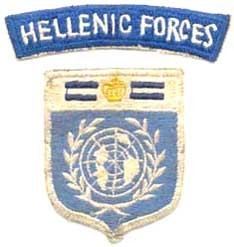Founded 1950 | ||
 | ||
Active November 1950 – May 1958 Part of 1st Cavalry Division, 3rd Infantry Division Similar Hellenic Army, British Commonwealth Forces K, Lochos, NDC‑GR, Hellenic Force in Cyprus | ||
The Greek Expeditionary Force (GEF) in Korea (Greek: Εκστρατευτικόν Σώμα Ελλάδος, abbreviated ΕΚΣΕ) was formed in response to the United Nations appeal for assistance in the Korean War. It comprised a reinforced Hellenic Army infantry battalion and a Royal Hellenic Air Force (RHAF) flight of seven transport planes. Greece was the fifth largest troop contributor to U.N. Forces in Korea.
Contents
RHAF Transport Flight
The seven C-47s of 13th Flight, with 67 Air Force officers and personnel, departed from Elefsis air base at 0830 on November 11, 1950. They belonged to the 355 Transport Squadron, known for its participation in the recent civil war. The majority of the officers and NCOs of this first mission were experienced airmen, being veterans of the Mediterranean and Middle East Theatre of World War II and the Greek Civil War.
On December 3, 1950, the first Greek aircraft landed on Korean soil. The Greek flight was immediately attached to the 21st Troop Carrier Sqn. (later renamed 6461 TC Sqn.) of the 374th Wing, United States Air Force, based initially at Daegu. From May 14, 1951, the flight was based at Kimpo air base where it remained until May 23, 1955. During its time in Korea, the Greek Flight carried out 2,916 missions, comprising air evacuations, the transport of personnel and prisoners, drops of supplies and ammunition, the replenishment of allied bases and the collection of operational information. In total, its planes carried 70,568 passengers, including 9,243 wounded. It logged 13,777 flight hours. Losses included 12 officers and NCOs and two C-47s.
Sparta Battalion
The Greek government originally intended to send a brigade to Korea, but with quick UN victories in the autumn of 1950, the expeditionary force was downgraded to a battalion. The army unit, called the Sparta Battalion, which was sent in November 1950 under Lieutenant Colonel Georgios Koumanakos, was composed of 849 men and six vehicles in an HQ company and three rifle companies; with one machine gun/mortar platoon and three rifle platoons in each. The men were all volunteers from the 1st, 8th and 9th Infantry Divisions.
From August 23, 1951, the component was expanded to 1,063 men, at which strength it remained until the December 1953 armistice. It was subsequently increased to the level of 2,163 men until April 1955. After the anti-Greek Istanbul Pogrom, in September 1955, relations with Greece's NATO ally, Turkey, deteriorated and Athens decided to recall its units stationed in Korea. As a result, only 191 men were still in the country by December 1955. A representative section of one officer and nine men remained until May 1958.
Battalion events timeline
Fifteen officers and 168 men were killed in action, while 33 officers and 577 men were wounded.
Awards and recognitions
The 13th Flight received a US Presidential Unit Citation for its participation in the evacuation of US Marines at Hagaru-ri in December 1950. The GEF battalion received its first US Presidential Unit Citation in February 1952 for the capture of Scotch Hill.
The Greek infantry company involved in the defense of Outpost Harry received the following Presidential Unit Citation:
"DEPARTMENT OF THE ARMY Washington D. C., 10 March 1955 GENERAL ORDERS 18
DISTINGUISHED UNIT CITATION Company P Greek Expeditionary Forces Battalion (Second Award) is cited for extraordinary heroism and outstanding performance of duty in action against an armed enemy in the vicinity of Surang-Ni, Korea during the period 17 June to 18 June 1953. Assigned the defense of a vital outpost position (Harry), the company encountered a major enemy assault on the evening of June 17. After an intense concentration of enemy mortar and artillery fire, the hostile forces, which had taken up an attack position on the northeast and northwest side of the outpost, moved rapidly through their own and friendly artillery fire to gain a foothold on the northern slope of the position. Refusing to withdraw, Company P closed in and met the attackers in a furious hand-to-hand struggle in which many of the enemy were driven off. The aggressors regrouped, quickly attacked a second time, and again gained the friendly trenches. Immediately, the Greek Forces launched a series of counterattacks, simultaneously dispatching a diversionary force to the east of the outpost which successfully channeled the enemy thrusts. After 2 hours of close-in fighting, the aggressors were again routed and the friendly positions restored. The outstanding conduct and exemplary courage exhibited by members of Company P, Greek Expeditionary Forces Battalion, reflects great credit on themselves and are in keeping with the finest traditions of the military service and the Kingdom of Greece."
Individual Greeks received six U.S. Distinguished Service Crosses, 32 Silver Stars, 110 Bronze Stars. 19 members of 13th Flight received the US Air Force Air Medal for the Hagaru-ri evacuation operation in December 1950. The Greek battalion's war flag also received the highest Greek military decoration, the Commander's Cross of the Cross of Valour, in 1954.
